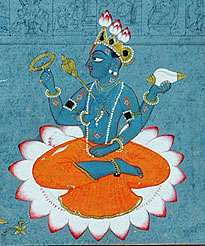Hayagriva
Hayagriva, also spelt Hayagreeva (IAST: hayagrīva, literally 'Horse-neck'[1]), is a horse-headed avatar of the Lord Vishnu in Hinduism.
| Hayagriva | |
|---|---|
God of knowledge and wisdom | |
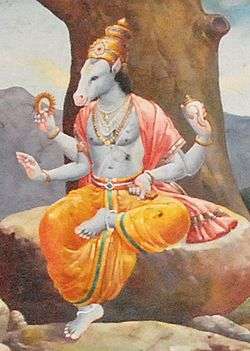 | |
| Sanskrit transliteration | Hayagrīva |
| Affiliation | Avatar of Vishnu |
| Consort | Lakshmi |
Hinduism
In Hinduism, Lord Hayagriva is an avatar of Lord Vishnu.[2] He is worshipped as the god of knowledge and wisdom, with a human body and a horse's head, brilliant white in color, with white garments and seated on a white lotus. Symbolically, the story represents the triumph of pure knowledge, guided by the hand of God, over the demonic forces of passion and darkness.
Origins about the worship of Hayagriva have been researched, some of the early evidences dates back to 2,000 BCE,[3] when people worshipped the horse for its speed, strength, intelligence.[4] Hayagriva is one of the prominent deities in Vaikhanasas, Sri Vaishnavism and Madhwa Brahmins traditions. His blessings are sought when beginning study of both sacred and secular subjects. Special worship is conducted on the day of the full moon in August (Śravaṇa-Paurṇamī) (his avatāra-dina) and on Mahanavami, the ninth day of the Navaratri festival. He is also hailed as "Hayasirsa".[5] Hayaśirṣa means haya=Horse, śirṣa=Head.
In IAST
jñānānandamayaṃ devaṃ nirmalasphaṭikākṛtiṃ
ādhāraṃ sarvavidyānāṃ hayagrīvaṃ upāsmahe
In Devanāgarī
ज्ञानानन्दमयं देवं निर्मलस्फटिकाकृतिं
आधारं सर्वविद्यानां हयग्रीवं उपास्महे
This verse is originally from the Pañcarātra Agamas but is now popularly prefixed to the Hayagriva Stotram of the 13th-century poet-philosopher Vedanta Desika. It is very popular among devotees of Hayagrīva.
Hindu iconography
Vedanta Desika's dhyāna-śloka (meditative verse) on Hayagrīva typifies this deity's depiction in Hindu iconography:
He has four hands, with one in the mode of bestowing knowledge; another holds books of wisdom, and the other two hold the Conch and Discus. His beauty, like fresh cut crystal, is an auspicious brilliance that never decays. May this Lord of speech who showers such cooling rays of grace on me be forever manifest in my heart!
In the Mahavairocana-sutra [Sūtra of the Great Sun] translated and copied in 1796 by I-hsing it says:
“Beneath the buddhas is Hayagriva. His body is the color of the sun at dawn. He wears flaming effulgence and skulls as a garland. His nails are long and sharp; his face shows a pair of bare tiger’s fangs. His hair is that of a burning lion’s mane.He is awesomely powerful and fierce! This is the fierce Vidyaraja of the Lotus section. He is just like a horse-jewel of a Cakravartin that wanders the four continents, nowhere and never does he rest, having all the great and terrible force of all the buddhas’. This is his nature, and therefore he possesses this terrible and all-mighty light. Amidst the greatest obstacles of death and evil he is without the slightest care for his own welfare, his conspicuous and uncommon gallantry, intrepidity, and wrath is legendary among the gods, and therefore he easily and quickly vanquishes all who oppose him! Many others submit to him at first sight! This is because though he is fierce and terrible; his heart is full of compassion (unbiased, dispassionate understanding).”
-- Hayagrīva Stotram, v.32
Later on Hayagriva is referred to as the “Horse necked one”, Defender of faith”, the “Terrible executioner”, the “Excellent Horse”, and the “Aerial horse”.
This said, the Horse Avatar of Lord Vishnu is seen as pulling the sun up to the heavens every day, bringing light to darkness. Hayagriva's consort is Marichi, the goddess of the rising sun, more accurately the sun's light which is the life force of all things, and which is seen as the female aspect of Hayagriva. Marichi represents the essence of the power of creation of the cosmos. Whereas Hayagriva represents the other male aspect.
In several other sources he is a white horse who pulls the sun into the sky every morning. In others such as the great epic Taraka-battle where the gods are fallen on and attacked by the Danava's [demons], Vishnu appears as a great ferocious warrior called Hayagriva when he comes to their aid. It says;
“Hayagriva appears in his chariot, drawn by 1,000 powerful steeds, crushing the enemies of the gods beneath him!”
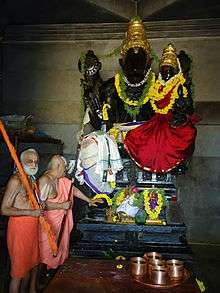
There are many other references to Hayagriva throughout the Mahabharata. It is said that Vishnu comes from battle as a conqueror in the magnificent mystic form of the great and terrible Hayagriva;
“The great Hayagriva having been praised in this way by the different saints and ascetics, assumes a great white horses head. The verda’s [mantras] made up his shape, his body built of all the great gods; in the middle of his head was Shiva, in his heart was Brahmā [god of heaven]; the rays of sun (Marichi) were his mane, the sun and moon his eyes; the Vasus and Sadhyas were his legs, in all his bones were the gods. Agni [Ka-ten; god of fire] was his tongue, the goddess Satya his speech, while his knees were formed by the Maruts and Varuna. Having assumed this form, an awesome wonder to behold to the gods, he vanquished the asura, and cast them down, with eyes that were red with anger.”
Invariably, Hayagriva is depicted seated, most often with his right hand either blessing the supplicant or in the vyākhyā mudrā pose of teaching. The right hand also usually holds a akṣa-mālā (rosary), indicating his identification with meditative knowledge. His left holds a book, indicating his role as a teacher. His face is always serene and peaceful, if not smiling. Unlike his Buddhist counterpart, there is no hint of a fearsome side in the Hindu description of this deity. Indeed, the two deities seem to be totally unrelated to one another.
Hayagriva is sometimes worshiped in a solitary pose of meditation, as in temple in Thiruvanthipuram. This form is known as Yoga-Hayagriva. However, he is most commonly worshipped along with his consort Lakshmi and is known as Lakshmi-Hayagriva. Hayagriva in this form is the presiding deity of Mysore's Parakala Mutt, a significant Sri Vaishnavism monastic institution.
In Sakta history
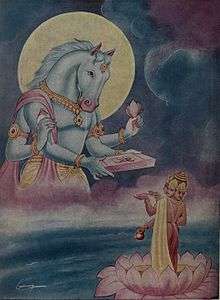
A legend has it that during the creation, the demons Madhu-Kaitabha stole the Vedas from Brahma, and Vishnu then took the Hayagriva form to recover them. The two bodies of Madhu and Kaitabha disintegrated into twelve pieces (two heads, two, four arms and four legs). Yet another legend has it that during the creation, Vishnu compiled the Vedas in the Hayagrīva form.
Some consider Hayagriva to be one of the Dashavataras of the Supreme Personality of Godhead. He along with Śrī Krishna, Shrī Rama and Shri Narasimha is considered to be an important avatar of the Supreme Personality of Godhead.
Lord Hayagriva is also amongst the deities present at the Ranganathaswamy Temple, Srirangam. Hayagreeva in Srirangam is very famous for children's education. The Sannidhi is very beautiful and all rituals are done according to Vedic principles very strictly.
Mahabharata, book 12, chapter 348, says the following: Having compassed the destruction of the two Asuras and restored the Vedas to Brahma, the Supreme Being dispelled the grief of Brahma. Aided then by Hari and assisted by the Vedas, Brahma created all the worlds with their mobile and immobile creatures. After this, Hari, granting unto the Grandsire intelligence of the foremost order relating to the Creation, disappeared there and then for going to the place he had come from. It was thus that Narayana, having assumed the form equipped with the horse-head, slew the two Danavas Madhu and Kaitabha (and disappeared from the sight of Brahma).
Hayagrīva Mahatmyam
| Part of a series on |
| Vaishnavism |
|---|
 |
|
Holy scriptures
|
|
Sampradayas
|
|
Related traditions |
|
|
A great devotee named ŚrīVadirajatirtha of Udupi Śrī Kṛṣṇa Mutt used to offer cooked horse gram (Kollu) to Lord Hayagreeva.[6] He used to recite the Hayagrīva Śloka and keep the offerings on his head. Lord Hayagrīva would come as a beautiful white horse form and would eat the horse gram. As a very staunch devotee, Vadirajatirtha would recite the following sloka -
Na HayagrivAth Param Asthi MangaLam
Na HayagrivAth Param Asthi Paavanam
Na HayagrivAth Param Asthi Dhaivatham
Na Hayagrivam Pranipathya Seedhathi!
There is no auspiciousness greater than Hayagrivan. Nothing is more sacred than Sri Hayagrivan to destroy our accumulated sins. No other God is superior to Hayagrivan. No one grieves after performing Śaraṇagati at the sacred feet of Hayagrivan.
Hayagriva is listed as one of the ten incarnations of Vishnu in Canto 10 (skandh 10), chapter 40 of the Śrīmadbhagavatam, and Akrūra's prayer contains Hayagriva's name when he had a vision while bathing in Yamuna.
There is a story that more than 500 years ago, a devotee from the Daivajña Brahmin community was casting an idol of Lord Gaṇapati, when it shaped itself in the image of Lord Hayagriva. Sarvabhauma Sri Vadiraja Guru Swamiji had a dream about this legend which inspired him to approach that devotee and take the idol from him in reverence. He then installed it in Shri Sode Vadiraja Mutt. Since then it has been worshipped there as the originating God of the Daivajnya Brahmin community.
The members of the community who were originally Smartha Brahmins, were instructed in Dvaita philosophy and received into the fold as Mukhya Śiṣyas by the revered Sri Vadiraja Teertha. To this day, Daivajña Brahmins continue to make offerings to the Mutt and Lord Hayagriva.
Temples of Hayagriva

Assam
- Hayagriv Madhav Dol at Hajo, Assam
Tamil Nadu
Most of the major Vishnu temples in Tamil Nadu have a separate shrine for Lord Hayagriva.
- Sri Lakshmi Hayagriva Temple, Thiruvaheendrapuram, Cuddalore, Tamil Nadu
- Sri Hyagreevar Temple, adjacent to Sri Koodal Alagar Perumal Koil, Madurai
- Sri Hyagreevar(ஸ்ரீ ஹயக்ரீவர்)swamy, Sri Chidambara Vinayagar Thirukoil, A. Vellalapatti (7 km from Alagarkoil or Melur), Madurai.
- Lakshmi hayagrivar temple in chithambara Nagar, near Ganapathi mill, at Tirunelveli
- Sri Lakshmi Hayagreevar perumal, at sri Kothandaramaswamy Devasthanam, Perumudivakkam, near Kannigaipair, (Chennai - Periyapalayam Highway), Thiruvallur District-601103.
- Yoga Hayagreevar and Gnana Saraswathi (This is a very rare combination and is generally worshiped for attaining both knowledge and power) in Vaitheeswaran Koil, Munusamy St, Amrithammal Colony, Perambur, Chennai - 600 011
- Chettypunyam Hayagriva Temple, near Chengalpattu, Tamil Nadu
- Sri Lakshmi Hayagriva Temple, Nanganallur, Chennai, Tamil Nadu.
- Lord Hayagriva Sannidhi in Thooppul Vilakoli(Deepa Prakasar) Perumal Koil in Kanchipuram.
- Vedanta Deshika Alayam, Mylapore
Pondicherry
- Sri Lakshmi Hayagriva Temple in Sri Ramakrishna Nagar, Muthialpet, Pondicherry
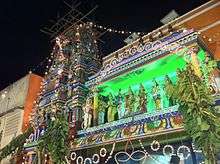 Sri Lakshmi Hayagriva Temple in Sri Ramakrishna Nagar, Muthialpet, Pondicherry
Sri Lakshmi Hayagriva Temple in Sri Ramakrishna Nagar, Muthialpet, Pondicherry
Karnataka
- Parakala Mutt, Mysuru - The Hayagriva idol handed down from Vedanta Desika
- Hayagreeva temple, Sattegala kollegala taluk chamarajanagar district karnataka
- Sri Lakshmi Hayagriva Temple, Tank Bund Road, Gandhi Nagar, Bangalore, Karnataka
- Sodhe Mutt, Sirsi, Karnataka
Andhra Pradesh
- Tirumala Hayagriva temple on North Mada street of Balaji Temple, Tirumala, Tirupati, Andhra Pradesh
- Sri Lakshmi Hayagriva Swami Temple, Machilipatnam, Andhra Pradesh
- Sri Lakshmi Hayagriva Temple, Thotlakonda, Visakhapatnam, Andhra Pradesh
- Sri Lakshmi Hayagriva temple, siddhashramam, Narasimhakonda, near jonnawada, Nellore, Andhra Pradesh
- Shri Lakshmi Hayagriva Swamy , installed in birthplace of Kethanda patti Swamy at Lakshmipuram, near Kuppam, Chittoor District, Andhra Pradesh.
- Sri Lakshmi Hayagriva temple, MF Road, Hindupur Mandal, Anantapur
Telangana
- Hayagriva Swami Temple Beechupalli Telanganaa
- Shri Lakshmi Hayagreeva Swamy Temple, Vangapalli Road, Yadagirigutta, Yadadri District, Telangana, 508115
Influence on other cultures
In the 2015 documentary series, The Creatures of Philippine Mythology, the spread of Hinduism and the imagery of Hayagriva is tracked through South East Asia. It is speculated that Hayagriva influenced the image of the Philippine horse-headed folk spirit, the Tikbalang.[7]
An extinct genus of basal neornithischian dinosaur known from Mongolia has been named Haya griva. This name refers to the elongate horse-like skull of Haya and the appearance of this deity in the Buddhist art of Mongolia.
See also
References
- Monier-Williams Sanskrit-English Dictionary
- Swami Parmeshwaranand (1 January 2001). Encyclopaedic Dictionary of Puranas. Sarup & Sons. pp. 632–. ISBN 978-81-7625-226-3. Retrieved 21 August 2013.
- T. Volker (1950). The Animal in Far Eastern Art: And Especially in the Art of the Japanese Netzsuke, with References to Chinese Origins, Traditions, Legends, and Art. BRILL. p. 102.
- Mārg̲, Volume 43. p. 77.Originally from = University of Michigan
- Inquiries into the absolute Archived 14 May 2008 at the Wayback Machine
- Śrī Vadiraja's lifehistory
- Clark, Jordan "Tikbalang: The Horse Demon" Episode 01, Creatures Of Philippine Mythology (2015) https://www.youtube.com/watch?v=gRUSBSJ39KY
- Lord Hayagriva
- Dictionary of Hindu Lore and Legend (ISBN 0-500-51088-1) by Anna L. Dallapiccola
Bibliography
- Prof. D. Sridhara Babu (1990). HAYAGRIVA - The Horse-headed Deity in Indian Culture. Sri Venkateshwara University - Oriental Research Institute, Tirupati.
- Veṅkaṭanātha (1978). Sri Hayagreeva Stotram of Vedanta Desika. Visishtadvaitha Pracharini Sabha.
- Devi Bhagawatam
External links
| Wikimedia Commons has media related to Hayagriva. |
